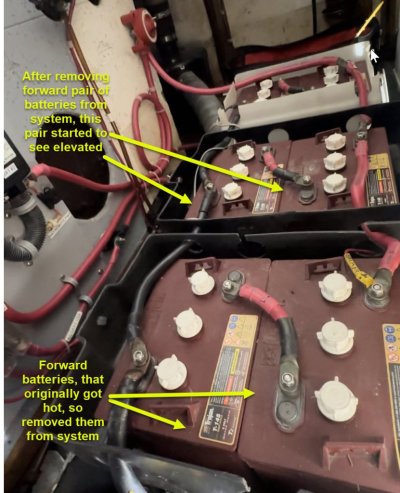Being this is my first trawler and experience with larger battery banks, I’m looking for input on whether I’m doing something incorrectly that is reducing the life of the house bank, and will compromise batteries going forward, or whether this sounds like standard end of life for battery bank.
My plan is to replace the entire house bank, but I don’t want to mindlessly go out and purchase new batteries, if there is a problem with the system.
Thanks for your input! -Ryan
- Purchased the boat 3- years ago and from the previous owner inherited inverter/charger (Magnum Pure Sine 2810) and house batteries (six, 6-volt Trojan 145 golf cart batteries wired in series-parallel to form a 12-volt bank). Batteries were reportedly purchased 5-years ago (Sept 2019)
- The system has operated smoothly for the past three years, performed general maintenance from the start, monitoring water levels, keeping batteries clean, and have not changed POs charge settings, and have observed float charge to be a consistent 13.5-volts.
- Over the past year specifically, and progressing over the last couple months of noticed more and more voltage drop to the point where the battery monitor indicates I’m at 80% capacity, yet the voltage is dropping into the low 11-volt range after an hour or two with pretty low load (< 10amps)
- I’ve also notices that in the past few months the batteries (specifically the forward pair) have required more DI water than previously to keep them topped,
- After returning from our trip in September I noted temperature of the forward pair of batteries was elevated when hitting them with a temp gun, temps topped out about 107 degrees (I’m in Alaska so ambient is relatively cool). Temps seemed to cool the following day but were still elevated. The other four batteries, including the battery with the temp sensor were at ambient temperature. I topped all the batteries off with DI water and left for two weeks.
- Upon returning to the boat, I again noted elevated temps on the forward pair of batteries (in the 90-degree range) and upon inspection of the cells, three of the six cells in the first two batteries were observed to be dry, with water well below plates. I added water, but temps stayed elevated and significant gassing was audible. Wanting to get another 10-day cruise out of the boat I decide to remove that pair of batteries from the system and went forward with a four-battery bank.
- In the two days prior to leaving port, I monitored the four-battery bank with a temp gun and found battery temps to be at ambient temps.
- We went cruising for the next ten days and the bank functioned sufficiently, still dealing with relatively quick voltage drop,
- Upon returning to port and charging them for a day or so, I again heard audible off-gassing. Hit the batteries with a temp gun, and these batteries temps were elevated into high 80’s, with consistent off-gassing.
My plan is to replace the entire house bank, but I don’t want to mindlessly go out and purchase new batteries, if there is a problem with the system.
Thanks for your input! -Ryan

